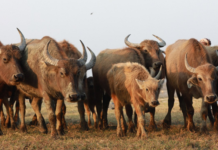Bangladesh struggles to protect the threatened Bengal tiger population in Sundarbans, with unchecked poaching blamed for the alarmingly low numbers.
The big cats continue to be a “critically endangered” species, experts say.
“We have to stop poaching in the mangrove forests. In the past year alone, three unnatural deaths of the tiger is unfortunate,” M. A. Aziz, a zoology professor at the Jahangirnagar University of Bangladesh.
Tiger poaching is the reason for the significant fall in numbers, causes 97 per cent of the population lost in the past 100 years.
In the 2018 tiger census, there are 114 Bengal tigers in the Sundarbans, a slight increase from the 106 reported in the previous year. However, it is a dreadful fall in numbers since 2004, when the tiger population was 440.
Experts say the conservation of the big cat is in progress.
“We are continuously working to raise the tiger population, and our efforts are yielding good results as the latest census says tigers increased by eight,” Modinul Ahsan, a deputy project director with Bangladesh Forest Development.
In recent years, authorities have carried out round-the-clock smart patrols in the forests to create safe breeding environments for the tigers.
The forest department is in the progress of a tiger conservation project to be in place by early 2021 at an estimated cost of $400,000.
As part of the project, it will conduct the camera-trapping census again. Efforts will be to relocate the tigers once the project is in place.
About 1 million people in the neighbouring areas of the Sundarbans depend on the forest for their livelihoods. However, the government declared a large portion of the mangrove as a reserve forest.
The Tiger population is at risk in Sundarbans. A total of 38 tigers died in the last 20 years in Bangladesh Sundarbans. Last five months, two more tigers died of old age reasons in the Sundarbans.
Between 2001 and July 2020, 38 tigers died, 22 in the East Division and 16 in the West Division of the Sundarbans.
However, last year, the Ministry of Environment, Forest and Climate Change said the number of Royal Bengal Tiger in Bangladesh part of the Sundarbans increased to 114 from 106.
The latest Tiger Survey conducted in 2018 claims there were 114 tigers in the Sundarbans.
Climate change exposes Sundarbans tiger habitats.
Royal Bengal tigers in the Bangladesh Sundarbans could be wiped off by 2070 because of climate change and sea-level rise.
Researchers forecast a Ceriops-dominated mangrove stretch along the India-Bangladesh border would potentially be the last refuge of the big cats in the Sundarbans.
Bangladesh and Australian researchers have conducted this study. The journal Science of The Total Environment published it.
“Our studies show a rapid falling-off the Royal Bengal tiger population and suitable tiger habitats in the Bangladesh Sundarbans area by 2050,” said the corresponding author of the study, Sharif A. Mukul.
With more than 10,000 square kilometres of areas, the Sundarbans region of Bangladesh and India is the most critical area for Bengal tiger survival.
“We found that climate change has a higher impact on Bengal tiger in Sundarbans rather than the sea level rise alone,” said Mukul, an assistant professor at Independent University, Bangladesh.
The study considered sea level rise as a consequence of climate change. The researchers examined suitable tiger habitats in the mangrove ecosystem where the tigers prefer to live. This space along the India and Bangladesh borders in the Sundarbans and is the site of Bangladesh’s Sundarban West Wildlife Sanctuary.
In Bangladesh Sundarbans, the three wildlife sanctuaries are Sundarban West, South and East. These sanctuaries cover around 23 per cent of the total Sundarbans reserved forest owned by the Bangladesh Forest Department.
The sanctuary of the Sundarbans increased from 139,700 hectares to 317,900 hectares among 601,700 hectares of forest area.
Considering this fact, it is inadequate. We know Sundarbans is the largest wild habitat of Bengal tigers and the only place where tigers are adapted to live in mangrove ecosystems.
Climate change predictions to determine the impact on tigers
In both scenarios, the combination of climate change and sea-level rise will lead to the total loss of Bengal tiger habitats in the area.
Important factors linked to this decline are rainfall in the summer season, vegetation (mangrove species) and maximum temperature of the warmest month.
The reason could be the control of Ceriops Decandra species of mangroves in this border stretch where salinity is relatively higher than the rest of the Sundarbans. Climate change would drive a tree species shift and also trigger extreme weather events adding to the effects of sea-level rise.
Health decline of Sundari trees in Sundarbans
However, there is no significant decline in the number of mangroves in the Sundarbans for the last 30 years. However, there is evidence of a 25% health decline of the mangrove trees. And, it is due to the effect of increased salinity on the Sundari tree. But the continuing climate change could critically hamper its ability to reborn.
Most significantly, the ‘top-dying disease’ is a cause for declining 15% of trees in the Sundarbans since the 80s.
Unfavourably, the Sundari tree is less tolerant of high salinity levels than other mangrove species and has previously identified as suffering from die-back due to rising salinity.
Tiger conservation
The government of Bangladesh should prioritise tiger conservation by designating more areas for tiger conservation, create corridors for transboundary tiger movements.
The fate will be the same in entire Sundarbans if the governments don’t take the necessary action to conserve and allow more areas dedicated to tiger conservation. Transboundary conservation measures by the Bangladesh and Indian governments are urgent.
Zulker Naeen
Climate Journalist
Zulker Naeen is a South Asia Fellow at Climate Tracker and a freelance climate journalist.
As a young climate advocate, his fellowship aims to share knowledge of climate change. Climate Tracker is a global media network that closely works on Climate Change.








